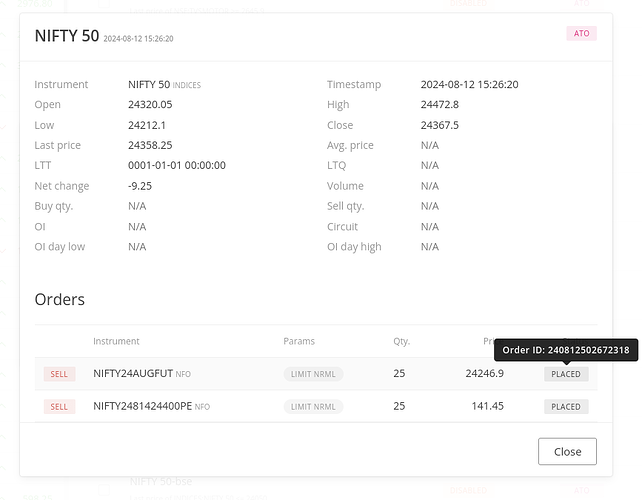We are excited to introduce a powerful enhancement to our Kite alerts feature: the ATO (Alert-Triggered Orders) Basket. This effective addition allows you to link a basket of orders to your alerts, which will be placed on the exchange upon the alert being triggered. This can be used as a standalone alert or an Alert-to-Order (ATO).
-
With Kite alerts, you can set real-time alerts based on various parameters. Now, you can link a basket of up to 20 orders to these alerts.
-
When the alert conditions are met, the associated basket of orders will be automatically placed on the exchange.
Practical Example:
-
For instance, if you want to invest in a NIFTY 100 ETF when the Nifty 100 index falls by 10%. You can create an alert for Nifty 100 falling by 10% and choose the ETF you want to invest in. Once your alert is triggered, an order to buy an ETF will be placed on the exchange.
-
For instance, if the Nifty 50 index reaches a predetermined price point, you can open or close a buy call spread, or any other strategy the client wishes to implement or close based on the spot price.
How to create ATO:
- Hover over an instrument on Marketwatch and click on More icon.
- Click on Create alert.
- The default alert name will be the instrument’s name. Enter a different name if preferred.
- Click on Alert Triggers Order (ATO).
- Select the data point, instrument, mathematical operator, and price. The price can also be set as a percentage of the last price. To learn more about setting Kite alerts, see What are Kite alerts and how to use them?
- Search for the instrument to be added to the basket and click on B (Buy), S (Sell) or +.
- Enter the parameters in the order window, such as price and order type and click on Add to basket.
- Click on Create.

Market Protection Orders:
- All market orders from the ATO basket will have market protections to avoid execution at unfavourable prices.
Allowed Segments:
- ATOs are allowed for NSE stocks, NFO (NSE index and stock derivatives), BSE stocks, and BFO (BSE index derivatives).
Modification, Disabling, or Deleting Alerts:
-
You can modify, disable, or delete your ATOs at any point up until they are triggered.
-
Hover over an order to rearrange its sequence, clone it, or delete it using on-screen buttons.

- You can toggle between buy (B) and sell (S) orders without opening the order window. Simply click on the instrument to open the order window for modifications. Quantity and price can be edited directly from the ATO basket.

- You can select and delete multiple orders at once from the ATO basket, or even select all orders with a single click.
Notifications:
- You will receive notifications via push notification on Kite and email upon the triggering and execution of an ATO.
Required Margin:
- The required margin for individual orders will be displayed next to each order, with the total required margin and final margin shown at the bottom of the ATO basket. The required margin indicates the funds needed to place the basket order, while the final margin represents the funds blocked in the Zerodha account after execution.
- Margins for ATO orders will be blocked only once the alert is triggered.
ATO Order Status:
- You can check the status of placed ATO orders through email notifications and on the ATO info page.
ATO Order Identification:
- ATO orders will be marked with a specific icon in the order book for easy identification.
Price-Affecting Factors:
- Alerts linked to instruments affected by corporate actions (like dividends, bonuses, splits, or rights issues) causing a price change of more than 2% will be disabled.
Validity:
Kite alerts and ATOs are valid for up to 365 days.
Important Note:
- Currently, the ATO feature is available only on the Kite web platform. We are working on making it available on the app in upcoming updates. Please note that if an ATO is created on the web, it will not be distinguishable on the app, and modifying an ATO via the app will convert it to a simple alert.
We value your feedback. Please feel free to share your thoughts and suggestions in the comments below. Your feedback helps us continually improve our services.
Happy Trading!
